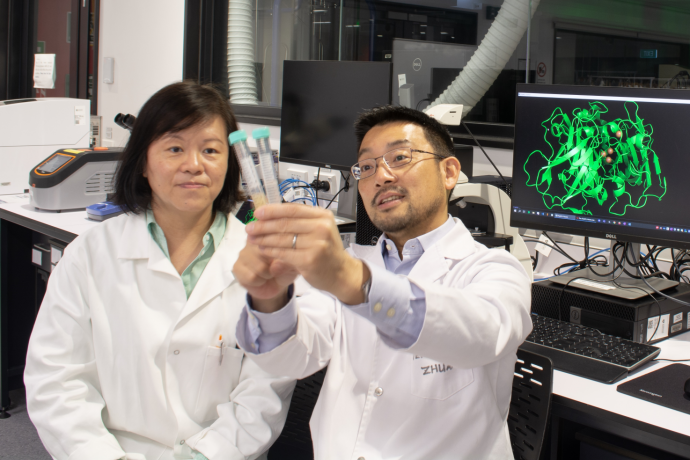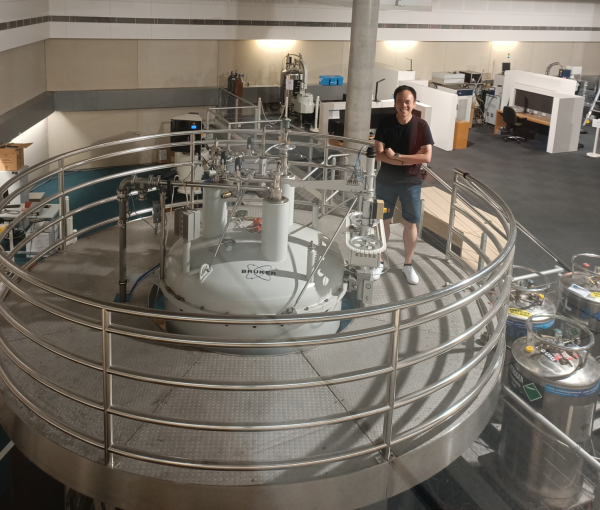Research
Published 5 April 2024Cleaner and greener solutions for industry: nature’s catalysts reimagined through state-of-the-art research

Oxidation is the chemical reaction that causes iron to rust, cut apples to go brown, and turns wine to vinegar. It also plays a crucial role in various industries, where it is used to transform raw materials into valuable products such as medicines, fuels, and chemicals. While oxidation occurs slowly as materials are exposed to air, it is necessary to speed up this reaction for industrial processes. This is often accomplished by using chemical catalysts, which can include harmful substances like heavy metals.
In this groundbreaking Marsden funded study, Dr Wei-Qin Zhuang of Waipapa Taumata Rau, The University of Auckland, and his team aim to make such industrial processes more sustainable and environmentally friendly by using nature’s biological catalysts - enzymes. Laccases are a group of powerful oxidative enzymes used by organisms such as fungi to break down wood.
Although the capabilities of laccases are well-studied, their application in industry is still in its early stages. This is because some natural laccases, such as those extracted from fungi, usually have high oxidative power but are relatively unstable. Other laccases, produced by bacteria, can withstand harsh industrial conditions but usually have a relatively low catalytic ability. This research team plans to bioengineer next-generation laccase-based biocatalysts that combine the desirable attributes of fungal and bacterial laccases for industrial applications.
To achieve this ambitious goal, the research team must first decipher the complex interplay between protein sequence, structural configuration, and catalytic potential of laccases from different organisms. To accomplish this, they are employing the latest technology, including artificial intelligence (AI). “The incorporation of AI in our research is not merely a nod to modern technology but a necessity. The complexity of enzyme structures and the myriad factors that influence their activity render traditional research methods inadequate, slow, and expensive. AI offers a means to sift through vast amounts of data, identifying patterns and connections that might otherwise remain obscured,” said environmental biotechnologist and Marsden Fund Principal Investigator Dr Wei-Qin Zhuang.

Associate Investigator Dr Ivanhoe Leung and the Nuclear Magnetic Resonance (NMR) machine at the University of Melbourne (Supplied)
This research is also supported by state-of-the-art biophysical instrumentation to visualise the structure of different laccases as well as the chemical reactions they catalyse. “The ability to study these biocatalysts with atomic resolution allows us to understand how laccases evolved to perform their biological functions. This information can then be used to feed the AI algorithm so that we can engineer new biocatalysts that balance between catalytic ability and stability,” as reported by biological chemist and Associate Investigator Dr Ivanhoe Leung, at the University of Melbourne, Australia.
The implications of this study extend beyond the confines of laboratories and industrial settings. In a world increasingly burdened by environmental challenges, the ability to harness the power of enzymes such as laccases could be a game-changer. From degrading pollutants to creating more sustainable manufacturing processes, their applications are as diverse as they are impactful. “One immediate application our team is exploring involves using these newly engineered enzymes to upcycle waste products from winemaking into useful chemicals. This is part of a related research project currently funded by Bragato Research Institute, a subsidiary of New Zealand Winegrowers,” explains biochemical engineer and Associate Investigator Dr Shan Yi of the University of Auckland.
The path to understanding and harnessing the power of laccases is fraught with challenges. As we continue to push the boundaries of what’s possible in biotechnology, studies like this remind us of the immense power residing in the smallest niches of nature. In pursuing their quest, these scientists are doing more than just exploring the minutiae of enzyme structures; they are paving the way for a more sustainable future, one tiny biocatalyst at a time.
RESEARCHER
Dr Wei-Qin Zhuang
ORGANISATION
Waipapa Taumata Rau The University of Auckland
FUNDING SUPPORT
Marsden Fund
CONTRACT OR PROJECT ID
UOA2219
